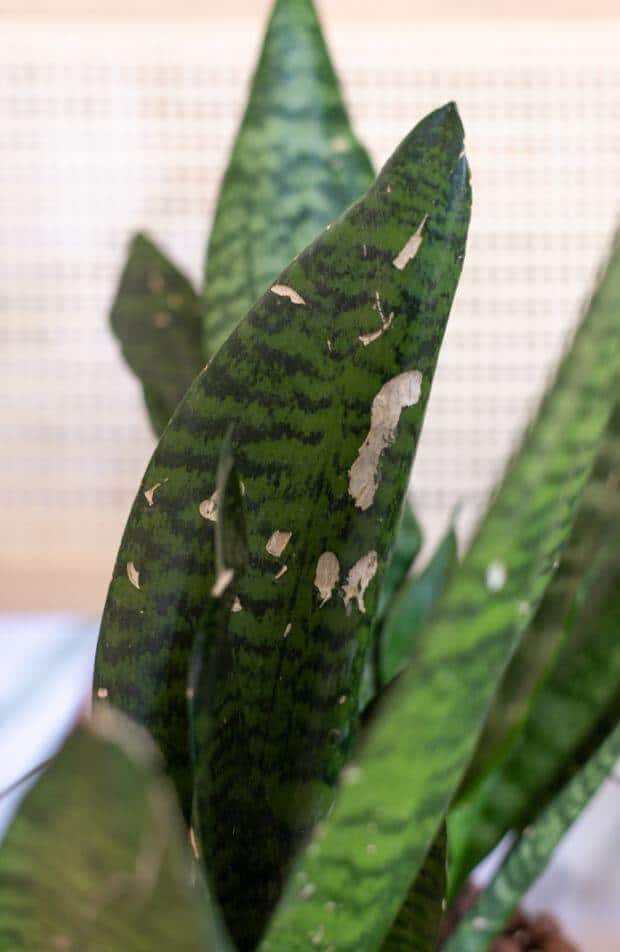Last Updated on June 7, 2023 by a Friendly Gardener
The Snake plant has lots of species with the most common being the Sansevieria or Dracaena trifasciata. This plant was named the Sansevieria until 2017 when it was botanically reclassified as a Dracaena species.
The Snake plant is a popular favorite of indoor gardeners. Often called the Mother-in-law’s tongue due to pointy leaves, this plant boasts a sculptural appeal thanks to thick foliage shaped like swords that grow skyward. This houseplant is difficult to kill, forgiving of a lack of watering, of temperature changes, and shows great adaptability in low light conditions. They can grow from six inches to almost two feet tall.
Belonging to the Asparagus family or Asparagaceae. Considered a west-African plant the Dracaena genus includes more than 120 various species that can e found in Asia, Australia, Africa, and even some parts of South America. Snake plants grow from underground rhizomes and prefer warm weather and dappled light for 10 to 12 hours, but cooler nights
Holes in the Leaves
When the foliage develops holes, it can ruin this plant’s aesthetics. Many gardeners attribute the presence of holes in the foliage to snails or slugs. However, it would be uncommon to find snails munching holes in healthy Dracaena plants as the foliage is very tough featuring a waxy thick cuticle.
A snake plant with holes in leaves is generally symptomatic of a plant that has been overwatered or that is not receiving sufficient water. This may seem like a contrast, but it is characteristic of both conditions.
When watering a Snake plant, do so gently maintaining the soil moist. Soil beds should be allowed to dry out completely before watering them anew. If you have doubts about how you are watering, use a soil bed moisture meter.
Snake plants will tolerate drought to some extent. For this plant to suffer from underwatering, it must be neglected for a considerable period. Rhizomes store water, so your plant isn’t going to manifest holes in foliage just because you’ve forgotten to water it once or twice. Holes in foliage signal a very unhappy plant.
To prevent holes from forming, give your plant approximately 12 hours daily of dappled sunlight and moist, well-draining soil. Warmer daytime temperatures and cooler nighttime temperatures are ideal for photosynthesizing. With these environmental conditions, leaves will feature tough waxy surfaces that protect it from pests, disease, and holes. If you suspect some nibbling by snails or slugs, apply snail bait or traps to prevent pest problems.
Common Snake Plant Problems
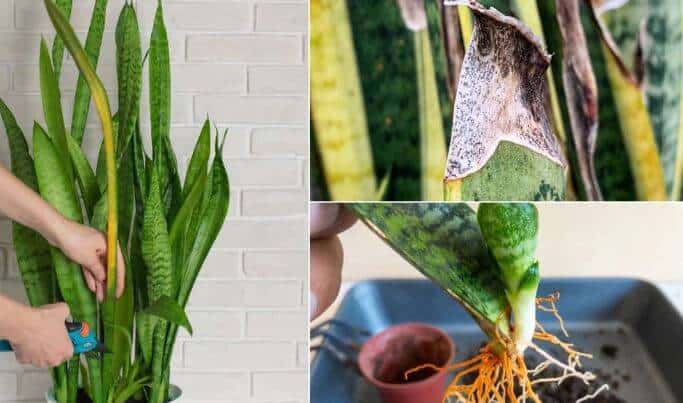
Despite the hardiness of these plants, there are several things that can go wrong. Common Snake plant problems might include a lack of growth, brown spots on foliage, or even leaves that begin to droop. Fortunately, many of the problems with snake plants are relatively easy to correct.
Bending or Drooping Leaves
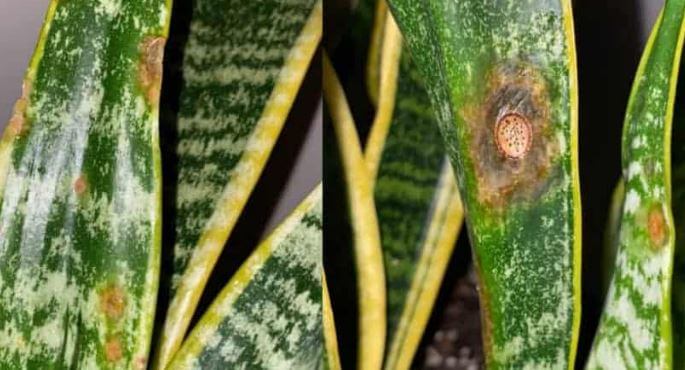
Snake plant foliage is known to grow upright, so if leaves begin to bend over, your plant is manifesting that it has a problem. The most common cause of droopy leaves is overwatering. Snake plants resemble succulents which means they store some of their own water. One reason they can tolerate a bit of drought or neglect is water storage.
Overwatering your plant may lead to root rot. If roots become damaged from sitting in water they will not be able to send nutrients and water throughout the plant and leaves may begin to droop.
Underwatering can also cause leaves to droop. If leaves receive insufficient water, they will thin and lose the necessary strength to remain upright.
For both over and underwatering, you will need to adjust the watering frequency. Underwatering is less dangerous than overwatering. Water when the soil bed has dried out completely.
A final cause of drooping leaves can be heat stress. Remember to provide your plant with lots of generous indirect bright light.
Narrow Leaves

Narrow thin leaves are typical of etiolation or when your plant is not getting sufficient light. The foliage will begin to stretch toward a light source and consequently leaves become thin, narrow, and “stretchy”. This is unattractive but can be resolved by moving your plant to a spot with more indirect bright light.
Once leaves have grown this way, they cannot be improved. You can wait for new shoots and repot them or take cuttings for propagation.
Mushy, Soft Leaves
Healthy Snake plant foliage will be firm and thick. Serious problems with snake plants include mushy, soft leaves. These are a sign of overwatering. Leaves will have too much water and start to disintegrate, eventually dying. Mushy leaves can also indicate a drainage problem. Repot your plant in a growing medium formulated for succulents. Remove damaged roots and trim away compromised leaves.
Deformed Leaves
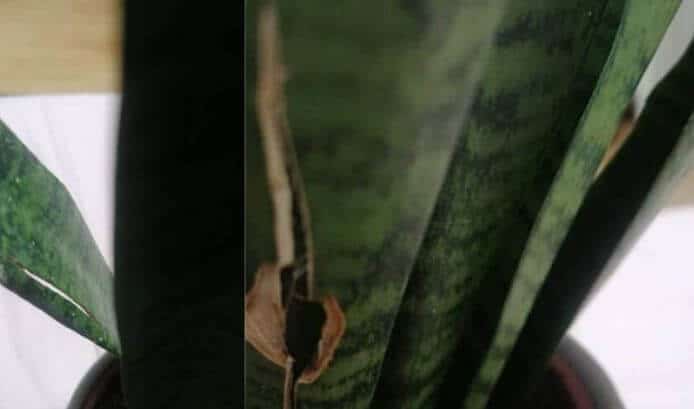
If foliage begins to look misshapen, you may have a pest infestation. Mites and thrips are sap suckers. They live on the leaf surface and suck the juice from the foliage. If this continues long-term, leaves will become deformed. Pests can be treated with insecticidal soaps or with horticultural oils like Neem oil.
The disease is another cause of misshapen leaves. Fungal infections can cause leaves to change appearance. If the infection is mild, trim away affected plant parts and apply a fungicide. Severe disease may require disposing of the plant.
Brown Leaf Tips
Brown spots on foliage or tips may be due to bad transportation or damage to a plant. These leaves can be pruned away. Another reason is extreme environmental conditions such as frost. Frost will kill plant cells as will exposure to excess sun.
Too much fertilizer can also cause brown tips and spots. Beware of over-fertilization and flush your plant every three to four months to prevent salt and chemical buildup in soil beds.
Yellowing Leaves
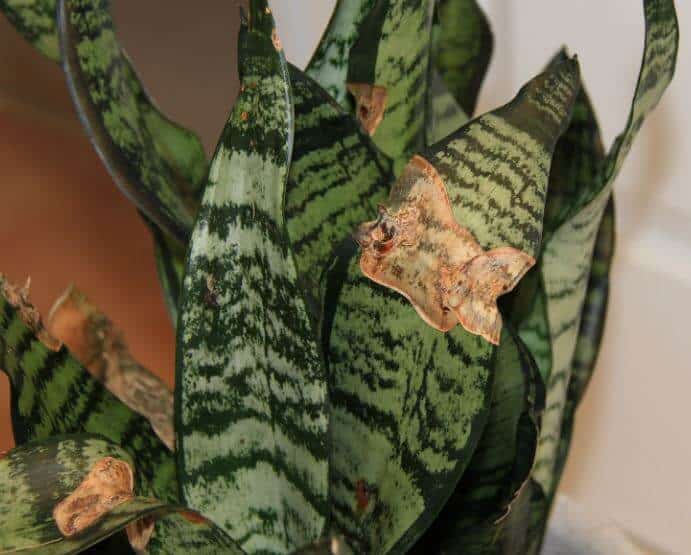
The principal cause of yellowing foliage is overwatering. As roots rot when left sitting in soggy soil, they will not send necessary nutrients to foliage resulting in yellowing. Test your soil before watering. Occasionally pests can also cause yellow leaves.
Wrinkled Leaves
Snake plant leaf damage can include the wrinkling of leaves. Dull, wrinkled foliage indicates a problem. Generally speaking, this may be the result of the wrong environmental temperature. If the weather is exceptionally warm, your plant may feel heat stress causing its foliage to wrinkle. Excessive sunlight exposure can also be a cause.
Underwatering can also cause the wrinkling of foliage if there is insufficient water in the leaves to maintain plumpness.
Repotting or moving a plant can also contribute to wrinkling due to stress.
Curling Leaves
Snake plant leaves are usually wide and flat. Twisting or curling leaves indicate your plant has a problem and it’s generally underwatering. Occasionally pests can be the cause as well as overfertilization. Remember that Snake plants are not heavy feeders, so dilute your fertilizer as a precaution.
Mushy Roots
This is typical of root rot due to drainage problems or overwatering. Cut away and remove any damaged roots. Repot your plant in fresh dry soil.
No Growth
As slow growers, this isn’t an easy problem to spot. It can be the result of your plant being root-bound. Repot your plant approximately every three years in a pot that is a size or two larger. Your plant may also have used up all the nutrients in the soil and need fresh soil.
A lack of sunlight can block growth, so try moving your plant to the sun with more bright indirect light to improve the plant’s ability to photosynthesize.

